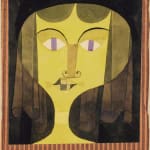





Paul Klee
Bildnis einer Veilchenäugigen (Portrait of a Violet-Eyed Woman), 1921
Signed 'Klee' (upper right); titled 'Bildnis einer Veilchenäugigen' (lower center on the artist's mount); dated '1921' and numbered '/65' (lower left on the artist's mount)
Watercolor and brush and ink over pencil on paper laid down on tissue paper, laid down on the artist's mount
Image: 22.1 by 19.1 cm (8⅝ by 7½ in.)
Mount: 32.7 by 24.8 cm (12⅞ by 9¾ in.)
Mount: 32.7 by 24.8 cm (12⅞ by 9¾ in.)
64536
© 2024 Artists Rights Society (ARS), New York / VG Bild-Kunst, Bonn
Further images
Executed in 1921. Bildnis einer Veilchenäugigen is a highly ornate and stylized portrait of a woman identified only by the color of her piercing violet eyes. The composition is filled...
Executed in 1921.
Bildnis einer Veilchenäugigen is a highly ornate and stylized portrait of a woman identified only by the color of her piercing violet eyes. The composition is filled with a series of connected lines and geometric forms that are animated by Klee’s bright palette dominated by yellow, ocher, and violet tones. The figure’s almond shaped eyes align with the oval shape of her mouth; the curves of her eyebrows are echoed in the hair covering her forehead and the sinuous line of her neck, and her nose mimics an overturned Ionic column. Klee purposefully creates these visual connections to hint at classical beauty and order, while offering a witty and satirical take on the classical concepts. This watercolor is set against a striped gold wallpaper that enlivens the composition and emphasizes the verticality of the figure’s hair and the rhythmic quality of her undulating locks.
Galka E. Scheyer (1889–1945), the first owner of Bildnis einer Veilchenäugigen, played a crucial role in disseminating Klee’s art among American collectors. It was Scheyer who founded the Blue Four—a group of artists that consisted of Klee, Wassily Kandinsky, Alexei Jawlensky and Lyonel Feininger—with the idea of promoting and selling their work, particularly in California. Scheyer organized a number of their group as well as solo exhibitions, thus widening the artists’ influence in the United States.
Bildnis einer Veilchenäugigen is a highly ornate and stylized portrait of a woman identified only by the color of her piercing violet eyes. The composition is filled with a series of connected lines and geometric forms that are animated by Klee’s bright palette dominated by yellow, ocher, and violet tones. The figure’s almond shaped eyes align with the oval shape of her mouth; the curves of her eyebrows are echoed in the hair covering her forehead and the sinuous line of her neck, and her nose mimics an overturned Ionic column. Klee purposefully creates these visual connections to hint at classical beauty and order, while offering a witty and satirical take on the classical concepts. This watercolor is set against a striped gold wallpaper that enlivens the composition and emphasizes the verticality of the figure’s hair and the rhythmic quality of her undulating locks.
Galka E. Scheyer (1889–1945), the first owner of Bildnis einer Veilchenäugigen, played a crucial role in disseminating Klee’s art among American collectors. It was Scheyer who founded the Blue Four—a group of artists that consisted of Klee, Wassily Kandinsky, Alexei Jawlensky and Lyonel Feininger—with the idea of promoting and selling their work, particularly in California. Scheyer organized a number of their group as well as solo exhibitions, thus widening the artists’ influence in the United States.





